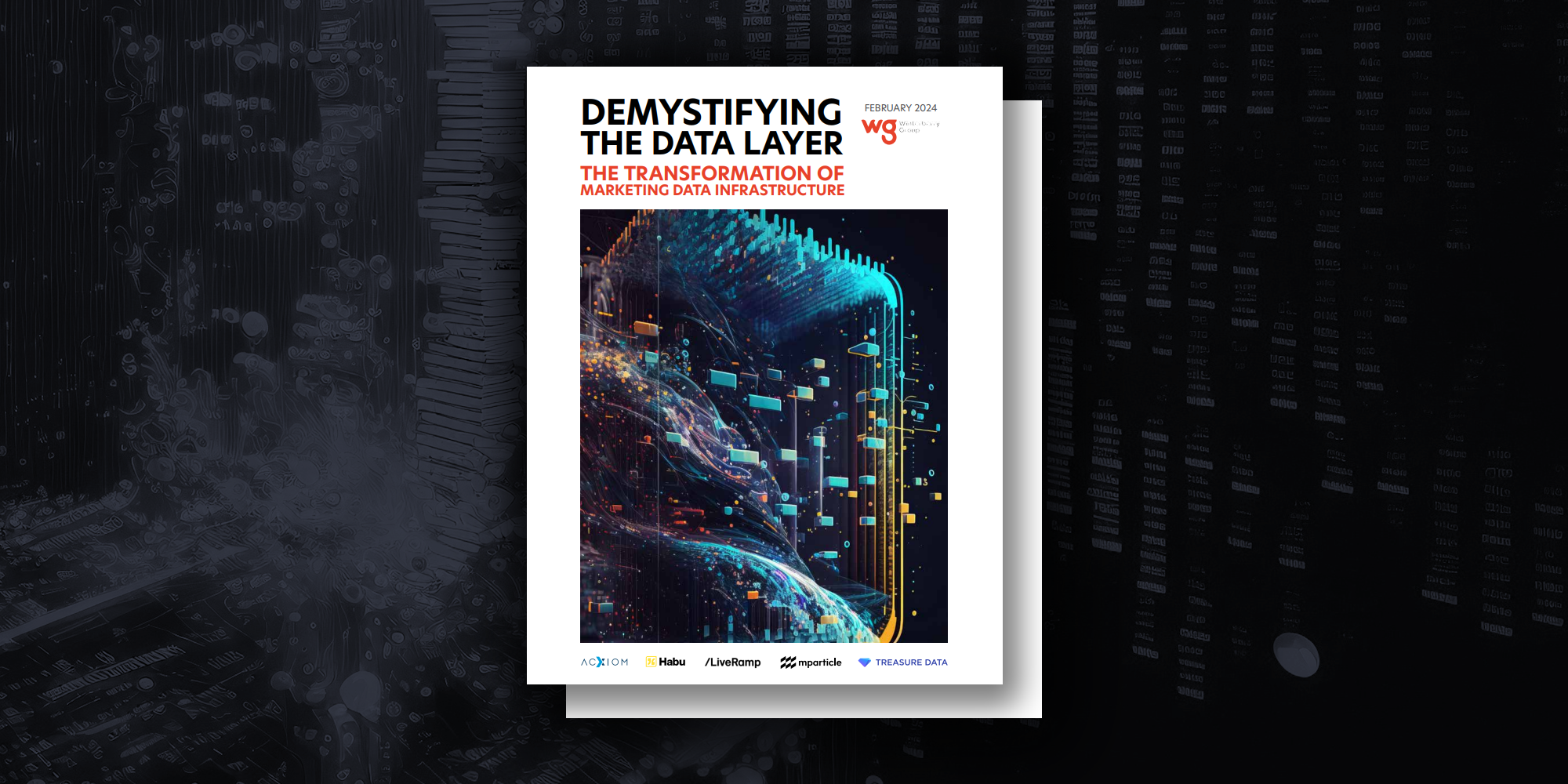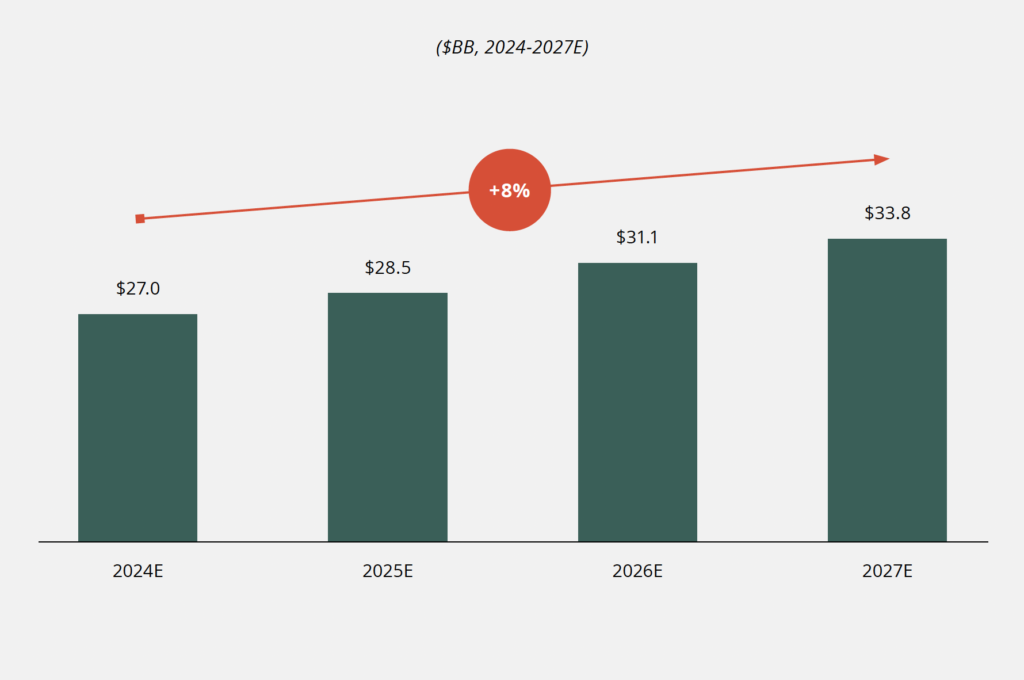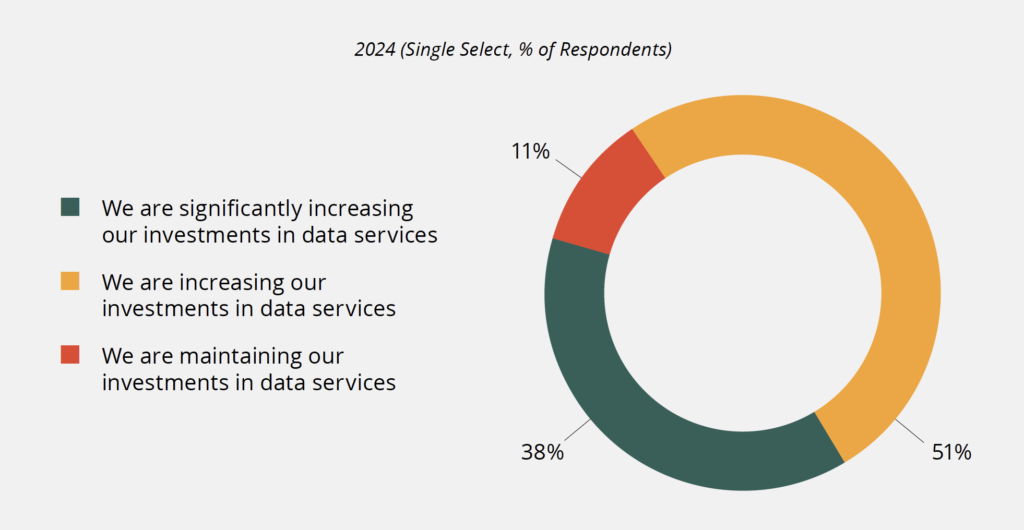

By Chet Dalzell, Digital Advertising Alliance
Each and every year since 2008, the Marketing Club of New York receives firsthand details on U.S. media spending, courtesy of Bruce Biegel and Winterberry Group. It’s the club’s marquee research event on the New York advertising, media and marketing calendar. One of the delights of that report is an inclusion and examination of data spending to support our professional activity.
Last month, in new research, Winterberry Group has gone even deeper into “the data layer” – meaning the investments of data, data services and data architecture that support enterprise decision-making in marketing organizations. MCNY takes a closer look.
The new report “Demystifying the Data Layer: Transformation of Marketing Data Infrastructure (February 2024)” documents the components of this layer inside many organizations, and how they are changing – both in Europe and North America.
According to Winterberry Group, in the United States alone, $27 billion will be spent in 2024 on data, data services and data infrastructure to support an estimated $270 billion in U.S. media buying across data-driven channels. Data spend to support not just these channels – but the enterprise decision-making behind media and marketing selection — is projected to rise to more than $33 billion by 2027, the Company reports.
The paper explores core solutions in the data layer, including: master data management; identity graphs; data clean rooms; data lakes; customer data platforms; analytic data environments, data warehouses; customer relationship management platforms; and LLM [large language models] data warehouses.

U.S. Marketing Data, Data Services and Data Infrastructure Spending Projections, 2024-27.
Source: Winterberry Group, Demystifying the Data Layer: Transformation of Marketing Data Infrastructure, February 2024.
The paper is the culmination of insights derived from more than 60 expert interviewees in the advertising, marketing, publishing, regulatory, legal and agency sectors, conducted between October 2023 and February 2024. The interviews were supplemented by 200 respondents across the United States, United Kingdom, France and Germany, who answered a comprehensive survey.
Market Forces Driving the Enterprise ‘Data Layer’ and Current Transformative Effects
“Several market forces are transforming how enterprises responsibly collect and use data for marketing activation,” said Michael Harrison, managing partner, Winterberry Group, and a co-author of the research. “Increased privacy regulation, a rapid shift toward digital-centric performance media, and the evolution of tech driven by machine and learning and generative AI [artificial intelligence] are helping to build a centralized data infrastructure that can support many business use cases – involving insights, activation, optimization and measurement. We’re seeing brands and companies embracing this layer as foundational.”
Harrison noted that the data layer directly supports two other layers that comprise marketing and advertising technology ecosystems today: the intelligence layer, which supports deriving insights to inform decision-making in strategy; and the activation layer, where inbound and outbound communications channels reach customers and prospects – and are increasingly driven by both data and analytics. “Getting it right, understanding how to source, unify, parse and stage the data, is vital to successful business outcomes,” he said.
The paper also details some of the transformation underway in the current “omnichannel era” of marketing within and about the data layer:
- A shift toward cloud-based environments, to help manage scalability, flexibility, and aspects of cost-efficiency. Hybrid hosting approaches, which combine on-premises and cloud environments, are gaining traction, enabling optimized performance while ensuring robust data security and privacy measures;
- The design and establishment of persistent first-party identity graphs to link proprietary PII [personally identifiable information] data with third-party assets, enriching customer insights and personalization capabilities;

Marketing Organizations’ Intent to Invest in Data Services, 2024. Source: Winterberry Group, Demystifying the Data Layer: Transformation of Marketing Data Infrastructure, February 2024.
- The evolution of Customer Data Platforms (CDPs) from “systems of record” to unified intelligence and data management platforms capable of integrating persistent and non-persistent identifiers to support more relevant marketing efforts;
- Growing demand for Data Clean Rooms (DCRs) to enable collaboration within and across brands and media providers for targeted planning, analysis and measurement in a more secure, privacy-safe environment.
- Addressing challenges in content and audience data adoption and integration, particularly structured and unstructured data residing in digital asset and content management platforms. These efforts support the development of Large Language Models (LLMs) within the intelligence layer, enhancing data-driven insights and decision-making processes.
Sponsors of the Research Share Perspectives on Components of the Data Layer
This particular piece of Winterberry Group research is commissioned by numerous data and adtech/martech companies: LiveRamp, Habu (acquired by LiveRamp in January), Treasure Data, mParticle, Acxiom and Aqfer. Each of these companies have something to say about this underlying research.
“Data is critical to not only know customers, but deeply understand them across the many enterprise touchpoints and devices, screens, and browsers they engage with,” said Daniella Harkins, SVP of product GTM, LiveRamp. “As signal loss drives investment in first-party data, enterprises must extend the value of that data and enhance their identity strategies through strategic partnerships that unlock new insights driven by new second and third-party data relationships.”
“As the Winterberry research highlights, privacy-enhancing technologies such as clean rooms are now essential for ethical data-driven collaboration,” said Matt Kilmartin, co-founder & CEO, Habu. “It’s imperative for companies to possess flexible tools designed so both technical and business users can achieve any use case, driving business growth efficiently. And, these tools should be interoperable, empowering organizations to collaborate and scale with any partner, regardless of the cloud platform from which their data resides.”
“In the age of hyper-personalization and artificial intelligence, it’s never been more important to get your data layer right as Winterberry Group highlights in its research. We believe a CDP that brings together data and decisioning is the future-proof customer data foundation that global enterprises need to orchestrate enriched customer experiences and drive profitable growth,” said Karl Wirth, chief product & technology officer, Treasure Data.
“We’re experiencing a major platform shift right now as (predictive) AI is multiplying the value that can be extracted from customer data,” said Michael Katz, CEO, mParticle. “As such, the benefit of the CDP is evolving from creating operational efficiency via simplifying martech integrations to impacting business outcomes through better decisioning at scale. While every vendor will have some sort of AI offering, it’s important to look for a diverse set of ML pipelines to create the most surface area for generating business outcomes,”
“Winterberry’s report underscores the rapid evolution of marketing data, driven primarily by expanding digital channels, regulatory shifts, and technological advancements,” said Dana Goff, SVP and head of industry and solution strategy at Acxiom. “The findings reaffirm what we’ve long recognized at Acxiom – these changes, while challenging, offer opportunities for growth and innovation. To capitalize on this potential and thrive in a data-driven future, brands must adopt cloud-native, privacy-compliant data management and analytics solutions. Establishing a robust data strategy, supported by a strong foundation, is the path forward for businesses aiming for sustained market success in the digital era.”
Results of the full study, as a PDF, are available for download from Winterberry Group.
Related Posts
MCNY Announces Industry Executive Chet Dalzell of Digital Advertising Alliance to Serve as 2024 Club President
MCNY Announces Industry Executive Chet Dalzell of Digital Advertising Alliance to Serve as 2024 Club…
New Research Seeks to ‘Demystify the Data Layer’ – in the U.S., a $27-Billion Riddle
By Chet Dalzell, Digital Advertising Alliance Each and every year since 2008, the Marketing Club…
MCNY Welcomes Annual ‘Outlook’ for Estimated U.S. Ad & Marketing Spend in 2024
Alliant CEO JoAnne Dunn introduces Winterberry Group Senior Managing Partner Bruce Biegel who presented to…
Meet 2023 MCNY Silver Apple Honoree, Katie Keating
30 years ago, Katie Keating came to New York with a vision and never left…







